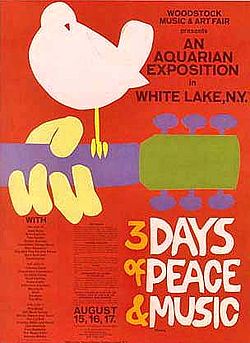 It’s August 2014 and forty-five years since the forever young Woodstock Music & Art Fair (Woodstock) was billed as An Aquarian Exposition: 3 Days of Peace & Music. On the original poster, its iconic graphic of a white dove on a guitar neck is forever ingrained alongside the dates August 15, 16 and 17, 1969. Held at Max Yasgur’s dairy farm in the Catskills, 32 music acts performed outdoors on 600 acres during the dog days of summer in a natural amphitheater carved out of field where the rain came in, doused and muddied a crowd of 500,000…
It’s August 2014 and forty-five years since the forever young Woodstock Music & Art Fair (Woodstock) was billed as An Aquarian Exposition: 3 Days of Peace & Music. On the original poster, its iconic graphic of a white dove on a guitar neck is forever ingrained alongside the dates August 15, 16 and 17, 1969. Held at Max Yasgur’s dairy farm in the Catskills, 32 music acts performed outdoors on 600 acres during the dog days of summer in a natural amphitheater carved out of field where the rain came in, doused and muddied a crowd of 500,000…
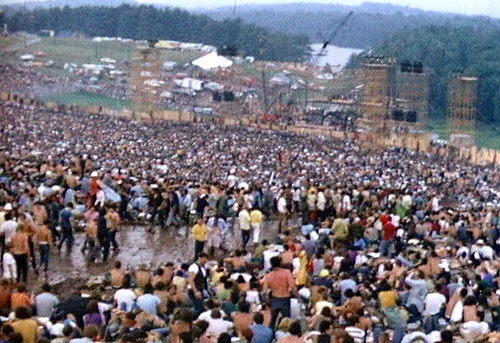
“By the time we got to Woodstock
We were half a million strong,
And everywhere there was song and celebration.
And I dreamed I saw the bombers
Riding shotgun in the sky
And they were turning into butterflies.”
“Woodstock” ©1969, 1997 Joni Mitchell, published by Crazy Crow Music
THE DECADE
The 1960s began as a turbulent decade with a Berlin Wall seemingly going up overnight in 1961 and the Cold War coming down hard. Seventy-million children came from the post war baby boom turning into teenagers and young adults in the 60s and living through changes that challenged the previous generation’s social lifestyles with the media spotlight on it: the first televised Presidential debates; astronaut John Glenn became the first American to orbit the Earth; a lunch counter sit-in at a racially segregated Woolwort’s in Greensboro, North Carolina; Andy Warhol exhibited his Campbell’s Soup can art; Rachel Carson published an environmental warning of pesticide annihilation in Silent Spring.
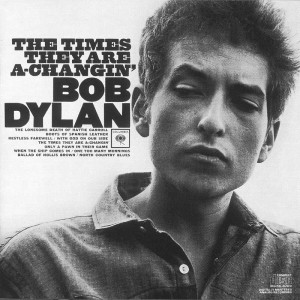 During the summer of 1963, Bob Dylan was working on his third studio album The Times They Are A-Changin’. He joined Joan Baez on activist singing tours that were full of stories about racism, poverty and civil liberty at a precarious time for political and social upheaval. In an interview, Dylan recalled writing the title track The Times They Are A-Changin’ “as an anthem that spoke to a generation intent upon change.” Civil rights activism and folk music were in sync at a time that highlighted a widening generation gap and political divide. Three weeks after John F. Kennedy’s assassination, the Emergency Civil Liberties Committee gave Dylan their annual Tom Paine Award for his “contribution to the civil rights movement,” but Dylan was already stepping away from the image of a protest singer.
During the summer of 1963, Bob Dylan was working on his third studio album The Times They Are A-Changin’. He joined Joan Baez on activist singing tours that were full of stories about racism, poverty and civil liberty at a precarious time for political and social upheaval. In an interview, Dylan recalled writing the title track The Times They Are A-Changin’ “as an anthem that spoke to a generation intent upon change.” Civil rights activism and folk music were in sync at a time that highlighted a widening generation gap and political divide. Three weeks after John F. Kennedy’s assassination, the Emergency Civil Liberties Committee gave Dylan their annual Tom Paine Award for his “contribution to the civil rights movement,” but Dylan was already stepping away from the image of a protest singer.
1964 Civil Rights Act Passes in U.S. • Hasbro Launches GI Joe Action Figure
By 1964, the Vietnam War was headed on a runaway course. A Congressional resolution gave President Lyndon Baines Johnson (LBJ), the authority to escalate U.S. involvement in Vietnam. In the Academy Award winning documentary Fog of War, filmmaker Errol Morris interviews then Secretary of Defense, Robert McNamara on his role as chief architect and casualty-counter. It was also a time of LBJ’s vision for what could transform America into The Great Society that would solve the monumental internal problems facing the nation. He set a specific timeframe for an ambitious effort for change that would test what the American government was capable of doing or not doing. While at the same time it heralded the Civil Rights Act in 1964, LBJ used his authority to order the first U.S. ground troops to Vietnam in March 1965. The Selective Service (military draft) was put into place while voting remained out of reach for young recruits as the voting age did not become 18 until 1971. Thousands were killed.
1965 • Los Angeles Riots • Malcolm X assassinated • miniskirt appears • New York City Great Blackout Rolling Stones’ hit– I Can’t Get No Satisfaction •
1966 • Mass protests of U.S Draft • National Organization for Women (NOW) founded
1967 • Che Guevara killed • First heart transplant • First Super Bowl • Six-Day War in the Middle East • 3 U.S. astronauts killed during simulated launch
THE MUSIC
Music transformation– merging and emerging –during the decade as Jazz musicians experimented with rock rhythms and electric instruments. Rock groups began incorporating Jazz elements into their music such as extended individual, free-form improvisation and borrowing traditional Jazz harmonics, melodies, rhythms and instrumentations. Jazz-rock grew out artistic subgenres–psychedelia, progressive rock and singer/songwriters. Notably, yet not completely accepted by the audience, music changes in 1967 occurred at the Newport Folk Festival with Bob Dylan’s electric guitar debut thus breaking down the barriers of traditional, absolute musical genres. With its underscoring emancipation during California’s “Summer Of Love,” bands like Jefferson Airplane and Grateful Dead sprang out of the musical voice of the counterculture with songs about new attitudes towards drug experimentation, sexual revolution, rebellion against racism, the Vietnam war and aspects of mainstream society no longer tolerable.
1968
Prague Spring • Martin Luther King assassinated • Robert F. Kennedy assassinated • Tet Offensive
1969
ARPANET (precursor of the Internet) • Charles Manson and his cult the Manson Family murders • Sesame Street air on Channel 13 Public Television
THE MUSIC FESTIVAL
With the sixties decade ending, society was in turmoil, the future uncertain. Music soothed, challenged and rocked. Howard Smith wrote in his May, 1969 Village Voice Scenes column, “This summer the magic youth word is ‘festival.’ There will be rocking sons and daughters of the Monterey Pop Festival all over the country all summer long.” Landing men on rock– the Moon –was high concept, but when, on July 20, 1969, Neil Armstrong hopped out the first steps on the Moon, plans were in high gear for a rock music festival in the Catskills.
The original proposal was to build a recording studio and a retreat for rock musicians up in Woodstock, New York where Bob Dylan and other musicians already lived. The plan turned into creating a two-day rock concert for about 50,000 people with the idea that a concert could raise enough money to pay for the studio. The Woodstock Music and Arts Festival– an Aquarian Exposition, embraced the Age of Aquarius notion refering to the advent of a New Age movement based on the ideas present in the expanding counterculture of an already matured “hippies” subculture. Hippies emerged from the Beat Generation (coming from the 1940s terms “hip,” “hep” and “hepcat” popular in Harlem Jazz) with the “Hip”-”Hipsters”-”Hippies” celebrating their creativity through art, music and above all, an alternative Bohemian lifestyle ready to explode at full throttle.
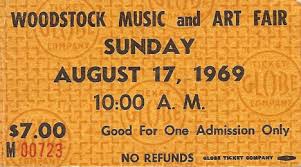 Tickets for the three, eventually four-day event cost $18 in advance and $24 at the gate. Ticket sales were limited to record stores such as Tower Records in the New York City metropolitan area, or by mail through a P.O. Box address. A huge number –186,000– of advance tickets sold quickly. The organizers thought maybe 200,000 festival-goers would turn up, but as hundreds of thousands made their way to the rural country in Bethel, it unintentionally turned into a free concert when early arriving crowds walked through and took down the incompleted fencing. Decriptions of massive traffic jams from the then progressive rock radio station, WNEW-FM, tried to discourage more arrivals. Undeterred, the crowds came anyway.
Tickets for the three, eventually four-day event cost $18 in advance and $24 at the gate. Ticket sales were limited to record stores such as Tower Records in the New York City metropolitan area, or by mail through a P.O. Box address. A huge number –186,000– of advance tickets sold quickly. The organizers thought maybe 200,000 festival-goers would turn up, but as hundreds of thousands made their way to the rural country in Bethel, it unintentionally turned into a free concert when early arriving crowds walked through and took down the incompleted fencing. Decriptions of massive traffic jams from the then progressive rock radio station, WNEW-FM, tried to discourage more arrivals. Undeterred, the crowds came anyway.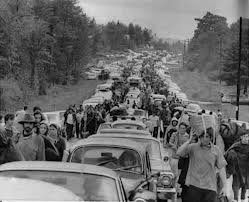
Billion year old carbon
We are golden
Caught in the devils bargain
And we’ve got to get ourselves
Back to the garden”
“Woodstock” ©1969, 1997 Joni Mitchell, published by Crazy Crow Music
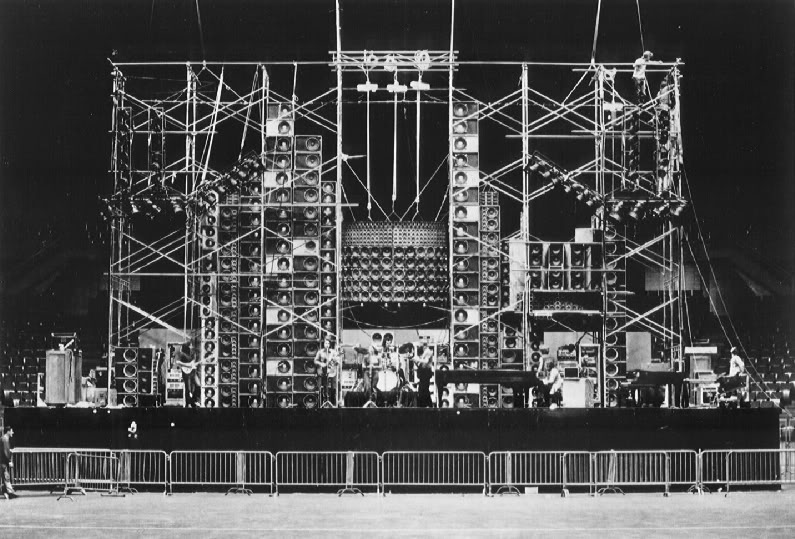 It is estimated that about 500,000 people got to the Woodstock Festival. Max Yasgur’s dairy farm formed a natural bowl sloping down to a pond on the North side. The stage was up at the bottom of the hill with the pond in the background becoming a popular skinnydipping destination. It was all there– in a rain-soaked, muddy pasture upstate New York. While Bob Dylan, who lived in the Woodstock area, was never in serious negotiation to appear in the lineup (he signed in mid-July to play the Isle of Wight Festival of Music in the UK) he begrudgingly noted he did not care for “the hippies piling up outside his house.” African American artists opened the concert event with Richie Havens (“Freedom”);
It is estimated that about 500,000 people got to the Woodstock Festival. Max Yasgur’s dairy farm formed a natural bowl sloping down to a pond on the North side. The stage was up at the bottom of the hill with the pond in the background becoming a popular skinnydipping destination. It was all there– in a rain-soaked, muddy pasture upstate New York. While Bob Dylan, who lived in the Woodstock area, was never in serious negotiation to appear in the lineup (he signed in mid-July to play the Isle of Wight Festival of Music in the UK) he begrudgingly noted he did not care for “the hippies piling up outside his house.” African American artists opened the concert event with Richie Havens (“Freedom”); 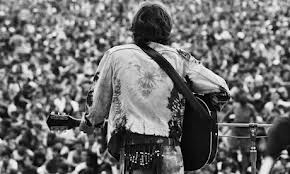 the music lineup prominently featured Latino artists (Santana) and one from India (Ravi Shankar) and closed with Jimi Hendrix. Hendrix’s rendition of the U.S. national anthem on Monday morning marked the end of the festival and became a poignant statement against the racial and cultural discrimination at the time thus becoming a defining moment of the decade representing a peaceful rebellion against some of the worst aspects in American mainstream society.
the music lineup prominently featured Latino artists (Santana) and one from India (Ravi Shankar) and closed with Jimi Hendrix. Hendrix’s rendition of the U.S. national anthem on Monday morning marked the end of the festival and became a poignant statement against the racial and cultural discrimination at the time thus becoming a defining moment of the decade representing a peaceful rebellion against some of the worst aspects in American mainstream society.
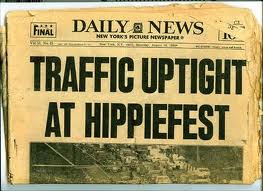 Newspaper articles dealt with issues of traffic jams and minor lawbreaking with headline spins of sensationalism– “Traffic Uptight at Hippiefest” and “Hippies Mired in a Sea of Mud.” There were reports of some on-duty editors at the major papers demanding their reporters write intentionally negative articles about the event. Coverage had to become more positive by the end of the festival as parents who received calls from their children, called the newspapers telling them that their reporting was misleading.
Newspaper articles dealt with issues of traffic jams and minor lawbreaking with headline spins of sensationalism– “Traffic Uptight at Hippiefest” and “Hippies Mired in a Sea of Mud.” There were reports of some on-duty editors at the major papers demanding their reporters write intentionally negative articles about the event. Coverage had to become more positive by the end of the festival as parents who received calls from their children, called the newspapers telling them that their reporting was misleading.
After the festival, articles written about the exodus from the site and the lack of violence at the event included quotes from the chief medical officer for the event and several local residents praising the festival goers. In tune with the idealistic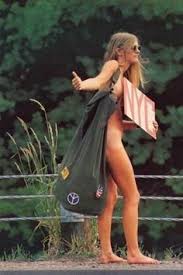 hopes for the future, Woodstock satisfied most attendees who left with a sense of social harmony they took away from the music and the overwhelming mass of people, whose Bohemian dress, behavior, and attitudes helped to make Woodstock one of the most accepting and enduring events of all time. Ultimately, the festival remains a major triumph for the peace and love generation, the Woodstock Generation.
hopes for the future, Woodstock satisfied most attendees who left with a sense of social harmony they took away from the music and the overwhelming mass of people, whose Bohemian dress, behavior, and attitudes helped to make Woodstock one of the most accepting and enduring events of all time. Ultimately, the festival remains a major triumph for the peace and love generation, the Woodstock Generation.
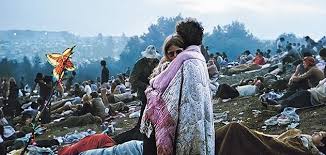 THE MOVIE
THE MOVIE
The film, Woodstock, directed by Michael Wadleigh, edited by Thelma Schoonmaker and Martin Scorsese received an Academy Award for Best Documentary Feature and was released in 1970. They wanted to make a film as much about the hippies as the music– listening to their opinions about compelling events in America at home to the Vietnam War at the world’s end– as well as the views from the local townspeople. Two soundtrack albums were released that included recordings of stage announcements, crowd noises and chanting between performances.
THE AFTERMATH
Lessons learned from this monumental event, a music festival, the New York State government and the town of Bethel passed mass gathering laws designed to prevent any more such large scale festivals from happening. Attempts have been made to prevent people from visiting the site where during one anniversary, tractors and state police cars formed roadblocks. There remains worldwide media interest in the Woodstock phenomenon and the 45th Anniversary will be no different. More than nostalgia, a place where the biggest rock festival of all time embodies a cultural touchstone for the late 1960s, Woodstock is iconic in popular culture and the Woodstock Generation will remain forever young.
“We are stardust
Billion year old carbon
We are golden
Caught in the devils bargain
And we’ve got to get ourselves
Back to the garden”
“Woodstock” ©1969, 1997 Joni Mitchell, published by Crazy Crow Music



07/29/2014
Music in Film, REEL Jersey Girl